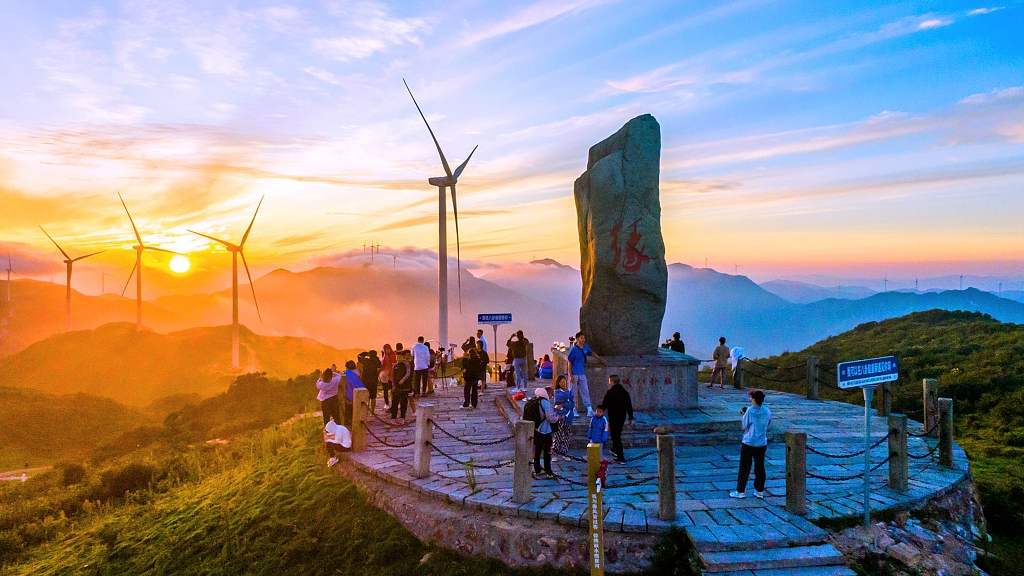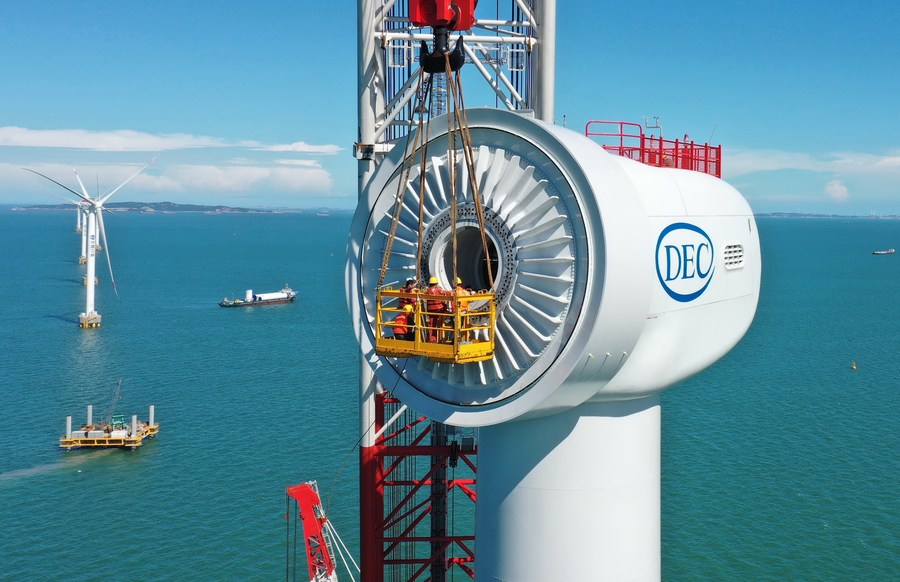
Tourists take photos of the sunrise and wind turbines at the mountain ridge of Baguanao Scenic Area in Shicheng County, east China's Jiangxi Province, August 30, 2022. /CFP
Tourists take photos of the sunrise and wind turbines at the mountain ridge of Baguanao Scenic Area in Shicheng County, east China's Jiangxi Province, August 30, 2022. /CFP
Editor's note: Djoomart Otorbaev is the former prime minister of the Kyrgyz Republic, a distinguished professor of the Belt and Road School of Beijing Normal University, and the author of the forthcoming book "Central Asia's Economic Rebirth in the Shadow of the New Great Game"(Routledge, 2023). The article reflects the author's views and not necessarily those of CGTN.
My previous posts on future energy have emphasized that renewables will play a critical role in the global transition to carbon neutrality and will emerge as the main factor to keep the increase in the average temperature on the planet below 1.5 degrees Celsius. The world is doing much to achieve this goal. For example, from 2000 to 2021, annual renewable energy capacity quadrupled from 754 gigawatts (GW) to 3,064 GW. Nonetheless, even this growth will be insufficient to achieve carbon neutrality by mid-century. It was also shown that wind generates as much energy as all other non-hydro renewable energy sources combined. Accordingly, we will discuss the future of wind energy.
Compared to other renewables, an additional advantage of using wind energy is that many new jobs are created during wind farms' construction, installation and maintenance. Experts have calculated that wind energy sources create more jobs than equivalent investments in fossil fuels. Last year, all renewable energy employment worldwide reached 12.7 million and added 700,000 new jobs in a year. New 470 GW of wind capacity planned worldwide for commissioning by 2025 will generate more than 3.3 million new jobs. This factor is essential, especially when making political decisions on investments in this sector of the economy. Governments recognize the social and economic benefits associated by expanding wind power.
Nearly two-thirds of all these jobs are in Asia. China alone accounts for about 42 percent of total employment, followed by the EU and Brazil at 10 percent each, and the U.S. and India at 7 percent each.
The apparent disadvantage of wind turbines is their high dependence on weather conditions. According to the U.S. Energy Information Administration, the country's average wind farm capacity utilization is only 34.6 percent, much lower than bioenergy plants with an average capacity of 63.5 percent and nuclear reactors of 92.7 percent.
In recent years, scientists and engineers have boosted the efficiency of wind turbines. Their efforts are concentrating on developing turbines with longer blades and taller towers that lower the overall cost of generating electricity. There are excellent prospects for developing such solutions for offshore installations, where environmental requirements are not as stringent as on land. Promising solutions are outlined in the development of floating offshore wind turbines. In this case, developers can use the unlimited potential of ocean areas with strong winds and too deep for stationary turbines.

Installing an offshore wind turbine at a wind farm in Fuqing, southeast China's Fujian Province, June 12, 2020. /Xinhua
Installing an offshore wind turbine at a wind farm in Fuqing, southeast China's Fujian Province, June 12, 2020. /Xinhua
To meet the Net Zero Emissions (NZE) scenario by 2050, around 7,900 TWh of wind power will need to be generated by 2030, which translates into an increase in average annual capacity growth to almost 250 GW, nearly three times the growth achieved last year. Experts say that one of the main reasons for the severe delay in the commissioning of new wind power facilities is the overcoming of bureaucracy in issuing permits for the construction of land-based wind turbines and the reduction in the cost of offshore wind turbines.
Without wind energy generation, it will be difficult to achieve the goal of carbon neutrality by 2050. According to experts, wind energy could provide 35 percent of global energy needs, becoming the primary source of global generation. By 2050, the total installed wind power capacity should reach 6,000 GW, which is more than 10times the current level, with 5,000 GW of wind power to be generated onshore and 1,000 GW offshore.
It is projected that with accelerated growth in energy demand, Asia in 2050 will become the dominant wind energy market, accounting for more than 50 percent of onshore and 60 percent of offshore wind installations. For example, onshore wind power capacity in Asia will have to grow to over 2,600 GW.
The analysis shows that new technological discoveries and inventions, more efficient supply chains and increased economies of scale should reduce the cost of electricity for onshore wind farms from the current level of $0.033/kWh to just over two cents per kWh by 2050. Offshore wind power prices will fall from $0.075 per kWh to below seven cents. This figure most likely falls below the electricity production based on fossil fuels.
By 2050, wind power could provide a quarter, or nearly 6.3 gigatonnes, of the annual reduction in carbon dioxide emissions needed by 2050. But to contain rising global temperatures and meet climate targets, annual investment in wind power must increase even more. In the first half of 2022, China doubled its wind energy investment to $57.8 billion compared with a year earlier. While in the U.S., investments amounted to $19.7 billion, with a growth of just 9 percent . By 2050, global investments in this segment market should reach a much more significant level of $311 billion U.S. dollars.
All evidence shows that wind energy production continues to grow at an unprecedented pace, but even this pace is not enough to achieve carbon neutrality by 2060. The world community, especially the leading countries, must make more efforts and, above all, make more investments to achieve that goal.
(If you want to contribute and have specific expertise, please contact us at opinions@cgtn.com. Follow @thouse_opinions on Twitter to discover the latest commentaries in the CGTN Opinion Section.)